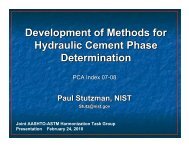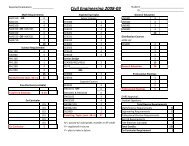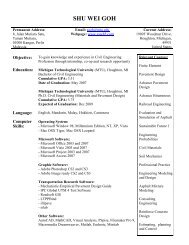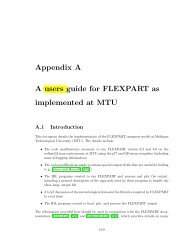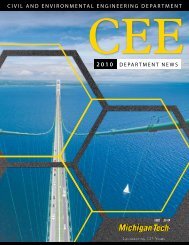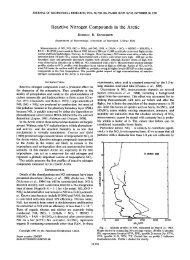Evaluation of Septic Tank and Subsurface Wetland for
Evaluation of Septic Tank and Subsurface Wetland for
Evaluation of Septic Tank and Subsurface Wetland for
Create successful ePaper yourself
Turn your PDF publications into a flip-book with our unique Google optimized e-Paper software.
Chapter 7 – Conclusions <strong>and</strong> Recommendations<br />
The Pisgah <strong>and</strong> Retrieve sanitation systems were evaluated to document wastewater<br />
treatment effectiveness <strong>and</strong> the impact <strong>of</strong> design parameters in local conditions.<br />
According to the results from five sets <strong>of</strong> water quality tests, it was determined that BOD<br />
was reduced by 78% at Pisgah <strong>and</strong> 50% at Retrieve; TSS was reduced by 85% at Pisgah,<br />
but increased at Retrieve; total nitrogen was reduced by 95% at Pisgah <strong>and</strong> 68% at<br />
Retrieve; ammonia was reduced by 99% at Pisgah <strong>and</strong> 97% at Retrieve; total phosphorus<br />
was reduced by 97% at Pisgah <strong>and</strong> 64% at Retrieve; <strong>and</strong> fecal coli<strong>for</strong>m was reduced by<br />
99.99% at Pisgah <strong>and</strong> Retrieve. Average effluent nitrate levels remained below 1.0 mg/l<br />
<strong>for</strong> both systems.<br />
Both <strong>of</strong> the sanitation systems per<strong>for</strong>med to the magnitude expected with a few<br />
exceptions. Total suspended solids were generated rather than reduced in the Retrieve<br />
wetl<strong>and</strong>, ammonia removal in both <strong>of</strong> the wetl<strong>and</strong>s was higher than what literature reports<br />
<strong>for</strong> other subsurface wetl<strong>and</strong> <strong>and</strong> coli<strong>for</strong>m reduction in the Retrieve septic tanks was<br />
higher than what literature reports <strong>for</strong> septic tanks. The effluent sample collection<br />
method at Retrieve was believed to be the primary cause <strong>for</strong> the unexpected TSS results.<br />
A normal SSF wetl<strong>and</strong> should reduce TSS at least as well as it reduces BOD (USEPA,<br />
2000). An erroneously high concentration <strong>of</strong> solids in the Retrieve wetl<strong>and</strong> effluent<br />
samples could also have negatively affected the other Retrieve effluent water quality test<br />
results. Absorption by wild cane <strong>and</strong> possibly adsorption by the rock media contributed<br />
to the high ammonia removal in both wetl<strong>and</strong>s. Over time the plants <strong>and</strong> media will age<br />
<strong>and</strong> the concentration <strong>of</strong> ammonia in the effluent may increase. The high reduction <strong>of</strong><br />
coli<strong>for</strong>m measured <strong>for</strong> the Retrieve septic tanks may have been caused by the continuous<br />
flow <strong>of</strong> chlorinated water through the urinal.<br />
Although determining the appropriate design size <strong>of</strong> a large wetl<strong>and</strong> requires estimating<br />
incoming loads <strong>and</strong> per<strong>for</strong>ming calculations using accepted mathematical models,<br />
persons designing small subsurface flow wetl<strong>and</strong>s <strong>for</strong> onsite wastewater treatment in<br />
55



